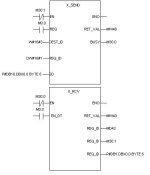Hi
I'm programming a Siemens S414 PLC in Step 7 and need to exchange data with a S414 and two S315 PLC's via Ethernet and several S315's via profibus.
I know I should RTM but if anyone can give me a quick example of how to read/write data from other PLC's over these type of networks I would be most grateful.
Also is it best to always read data or read and write data?
Is the transfer done by use of some message block function similar to RS Logix or is it possible to read or write to individual bits, bytes words etc.?
Thanks in advance
Dave
I'm programming a Siemens S414 PLC in Step 7 and need to exchange data with a S414 and two S315 PLC's via Ethernet and several S315's via profibus.
I know I should RTM but if anyone can give me a quick example of how to read/write data from other PLC's over these type of networks I would be most grateful.
Also is it best to always read data or read and write data?
Is the transfer done by use of some message block function similar to RS Logix or is it possible to read or write to individual bits, bytes words etc.?
Thanks in advance
Dave









